British and European Car Spotters Guide - 1950 |
|
|
 |
|
|
|
The British public flocked to the 1949 Earls Court Motor Show to look at the 1950 models which they had little chance of owning for many, many months - if at all, even if they could afford to buy. There was little respite either for those motorists who turned to the second-hand car market because the prices of year-old used cars were, generally speaking, well above list price - a phenomenom that would be repeated rarely in following years, namely some iterations of the Porsche 911. The monthly production average during 1950 was 43,543 of which 25,749 (complete) and 4,968 (chassis only) were for export.
Total car production for the year was 522,515 and 397,688 of these were exported. New UK registrations totalled 134,394 cars and 11,486 hackneys. Only 1375 cars were imported, valued at £359,005. The value of cars exported was more than £116t million. Design trends were favouring full-width bodies, enclosed rear wheels and smaller wheels with a larger tire section. In an effort to create more room inside, many car designers were opting for three-seater front bench seats which meant that the position of the gear lever had to be moved from the floor to the steering column. Notable newcomers introduced during the year included the Aston Martin DB2, Jowett Jupiter, MG Midget TO, Rover 75 and Triumph Mayflower. |
 |
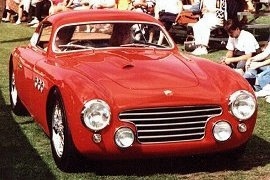 |
 |
Abarth Vignale |
| |
Also see: The History of Abarth (AUS Edition) |
| |
Engine: Cisitalia Inline-4, twin DR4SP Weber carburetors, 2 Valves per Cylinder
Displacement: 1089 cc / 66.5 cu in
Bore: 71.5 mm / 2.81 in
Stroke: 75 mm / 2.95 in
Compression: 10.5:1
Power: 55.9 kw / 75 bhp @ 6000 rpm (hp per liter: 68.87)
Body: Aluminum Body over Pressed Steel Frame
Brakes: Front & Rear Drums
Front wheels: F 4.5 x 15 cm / 1.8 x 5.9 in
Rear wheels: R 5.0 x 15 cm / 2.0 x 5.9 in
Steering: Worm & Sector
Front suspension: Porsche-Style Torsion Bars w/Trailing Links, Hydraulic Dampers
Rear suspension: Rigid Axle w/Semi-Elliptic Springs, Hydraulic Dampers
Weight: 818 kg / 1803 lbs
Wheelbase: 2210 mm / 87.0 in
Rear track: 1258 mm / 1248 in
Length: 3495 mm / 137.6 in
Width: 1420 mm / 55.9 in
Height: 1245 mm / 49.0 in
Transmission: 4-Speed Manual
Final drive: 3.7:1
Top speed: 170.0 kph / 105.6 mph |
|
 |
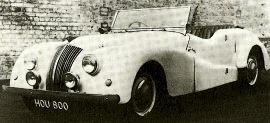 |
 |
AC 2-liter Buckiand Sports Tourer |
| |
Also see: AC Car Reviews | The History of AC (AUS Edition) |
| |
AC 2-liter Buckiand Sports Tourer. This model had all-new open coachwork by Buckland Body Works of Buntingford, Herts, and was distinguishable from the earlier 2-liter Drophead Coupe mainly by the full-length front wings and the one-piece, fold-flat windscreen. It was made until 1954. |
|
 |
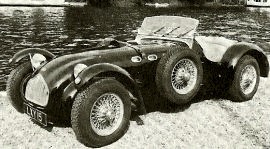 |
 |
Allard J2 Sports Roadster |
| |
Also see: Allard Car Reviews | The History of Allard |
| |
The Allard J2 Sports Roadster was powered by a 6-liter engine and a 440ci Chrysler VS respectively (to customer's requirements)-more usual were modified Ford V8 power units. The J2 was superseded by the modified J2X in the autumn of 1951. A two-door Saloon (Model P1) was also available. |
|
 |
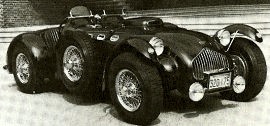 |
 |
Allard J2X Sports Roadster |
| |
Also see: Allard Car Reviews | The History of Allard |
| |
The Allard J2 Sports Roadster was powered by a 6-liter engine and a 440ci Chrysler VS respectively (to customer's requirements)-more usual were modified Ford V8 power units. The J2 was superseded by the modified J2X in the autumn of 1951. A two-door Saloon (Model P1) was also available. |
|
 |
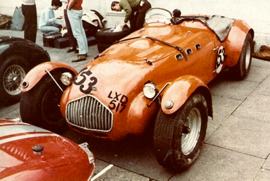 |
|
 |
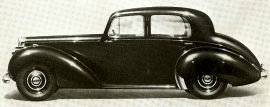 |
 |
Alvis Three liter Model TA 21 Saloon |
| |
Also see: Alvis Car Reviews | The History of Alvis |
| |
The Alvis Three liter, Model TA 21 Saloon had a similar body to the Fourteen (discontinued in October 1950), but was larger and followed more the classical line, with sweepingly curved wings, faired-in headlamps and traditional grille. |
|
 |
 |
 |
Armstrong Siddeley Typhoon / Lancaster Saloon and Hurricane Drophead Coupe |
| |
Also see: The History of Armstrong Siddeley |
| |
Powered by a 2·3-liter 18 HP engine which developed 75 bhp at 4200 rpm, with a choice of either preselector or synchromesh gearboxes. All three models were introduced in September 1949 to replace the previous 16 HP 1·9-liter-engined versions. The Typhoon was discontinued in May 1950. |
|
 |
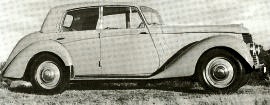 |
 |
Armstrong Siddeley Whitley Saloon |
| |
Also see: The History of Armstrong Siddeley |
| |
The Armstrong Siddeley Whitley Saloon was introduced in September 1949. Dimensionally similar to the Lancaster, but with semi razor-edged body styling and greater rear seat headroom, it used the same mechanical components as the Lancaster, Hurricane and Typhoon. Wheelbase of all models was 9 ft 7 in. |
|
 |
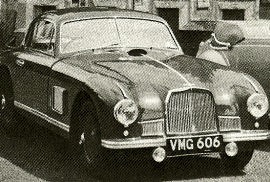 |
 |
Aston Martin DB2 Saloon |
| |
Also see: Aston Martin Car Reviews | The History of Aston Martin |
| |
The Aston Martin DB2 Saloon was first officially shown to the public at the New York Motor Show in April 1950, although a prototype version was entered-successfully-in competitions the previous year. The 2·6-liter twin-OHC engine, which produced 105 bhp at 5000 rpm. was fitted in an all-new light-alloy body; the bonnet and wing structure was hinged at the front so that with the bonnet raised the entire front end of the chassis could be exposed. |
|
 |
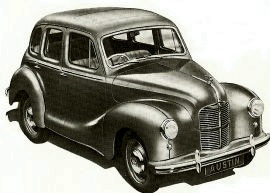 |
 |
Austin A40 GS2 Devon Saloon |
| |
Also see: Austin Car Reviews | The History of Austin (AUS Edition) |
| |
Austin A40 Models GS2 Devon Saloon and GP2 Countryman were carryovers from 1949 with detail modifications. The Devon was also available with bench-type front seat; this version was designated Devon Mark II, Model GS2A. |
|
 |
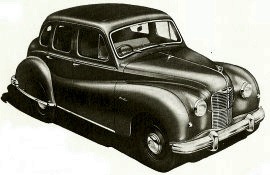 |
 |
Austin A70 Models BS2 Hampshire Saloon and BW3 Countryman |
| |
Also see: Austin Car Reviews | The History of Austin (AUS Edition) |
| |
The Austin A70 Models BS2 Hampshire Saloon and BW3 Countryman for 1950 had triangular vent panels in the front windows, like the 1950 A40 models. |
|
 |
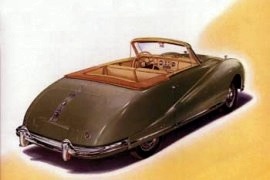 |
 |
|
| |
Also see: Austin Car Reviews | The History of Austin (AUS Edition) |
| |
The Austin A90 Atlantic Sports saloon, Model BE2, was introduced in September 1949. Powered by a 2·6-liter 88-bhp engine it was mechanically similar to the A90 Atlantic Convertible but with a higher axle ratio. |
|
 |
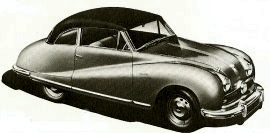 |
|
 |
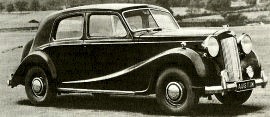 |
 |
Austin A125 Sheerline Model OS1 |
| |
Also see: Austin Car Reviews | The History of Austin (AUS Edition) |
| |
The Austin A125 Sheerline Model OS1 luxury saloon had a six-cylinder 3·9-liter engine. The Model OM1 Limousine was similar but had a lengthened chassis, different seating and other detail differences. |
|
 |
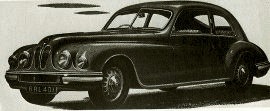 |
 |
Bristol 401 Saloon |
| |
Also see: Daimler Car Reviews | The History of Daimler (AUS Edition) |
| |
The Bristol 401 Saloon had a 2-liter 85-bhp Six engine and a top speed of 100 mph. The body was built by Bristol under Superleggera Touring patents and included concealed locks for fuel filler and luggage compartment. The bumpers had synthetic rubber inserts. |
|
 |
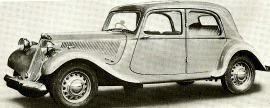 |
 |
Citroen Light Fifteen |
| |
Also see: Citroen Car Reviews | The History of Citroen (AUS Edition) |
| |
The Citroen Light Fifteen was a British-built edition of the French Citroen 11 Sport. It featured a walnut fascia board and other distinguishing differences to make it more suitable for British consumption, including wheels, bumpers, chrome-plated radiator grille, etc. Production ran from 1945 until 1955. |
|
 |
 |
 |
Daimler Straight Eight DE36 |
| |
Also see: Daimler Car Reviews | The History of Daimler (AUS Edition) |
| |
A Daimler Straight Eight DE36 chassis with Sports Saloon bodywork by Freestone and Webb. Other luxury cars were built on this chassis by well-known firms such as Hooper, Windover, etc. |
|
 |
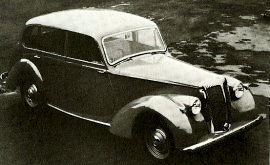 |
 |
Daimler DB 18 Consort Saloon |
| |
Also see: Daimler Car Reviews | The History of Daimler (AUS Edition) |
| |
The Daimler DB 18 Consort saloon differed from the earlier version (2½-liter DB18) by having a curved radiator grille, faired-in headlamps and sidelamps, and curved V-section bumpers. Mechanical improvements included a hypoid bevel final drive and hydro-mechanical brakes. |
|
 |
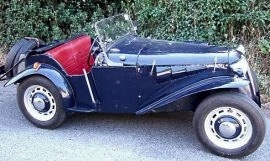 |
 |
Dellow Mark I Sports |
| |
|
| |
The Dellow Mark I Sports started life as a one-off trials special-the creation of K. C. Delingpole and R. B. Lowe (hence Dellow). In October 1949 it was introduced as a small-series production car, featuring a Ford Ten E93A engine (a supercharger was optional) and gearbox with Ford rigid front and rear axles, steering and brakes. The body was aluminum. |
|
 |
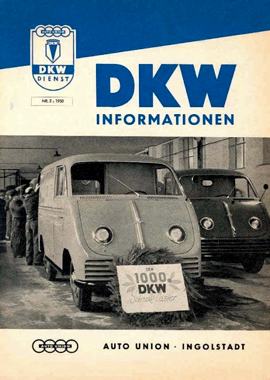 |
|
 |
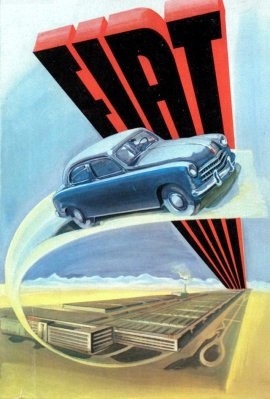 |
 |
Fiat 1400 |
| |
Also see: Fiat Car Reviews | The History of Fiat |
| |
The Fiat 1400 was introduced at the 1950 Geneva Motor Show. It was the first chassisless Fiat automobile. In 1953 the introduction of a diesel version with a 1900cc engine marked another Fiat first, although the diesel version was known as the 1400 Diesel. |
|
 |
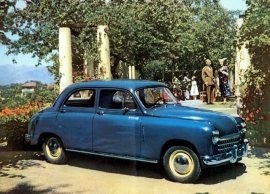 |
 |
Fiat 1400 |
| |
Also see: Fiat Car Reviews | The History of Fiat |
| |
A Fiat 1400 was tested by the British magazine 'The Motor' in 1950 had a top speed of 74.4 mph (119.7 km/h) and could accelerate from 0-60 mph (97 km/h) in 35.7 seconds. A fuel consumption of 24.2 miles per imperial gallon (11.7 L/100 km; 20.2 mpg-US) was recorded. The test car cost £750 including taxes on the UK market. |
|
 |
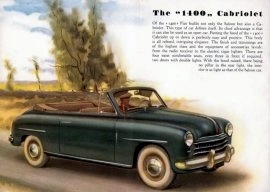 |
|
 |
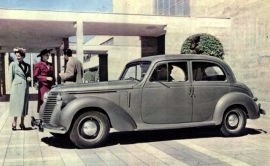 |
|
 |
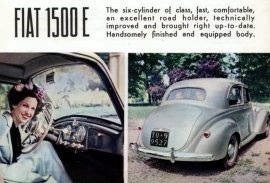 |
|
 |
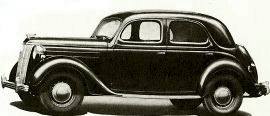 |
 |
Ford Pilot Model E71A Saloon |
| |
Also see: Ford UK Car Reviews | The History of Ford |
| |
The Ford Pilot Model E71A Saloon was a carryover from the previous year. It was powered by a 3·6-liter V8 engine. Production ceased in 1951. The two-door Anglia (E494A) was also continued unchanged. |
|
 |
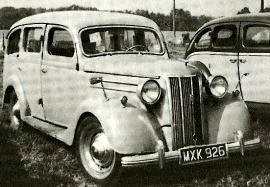 |
 |
Ford Pilot V8 Estate |
| |
Also see: Ford UK Car Reviews | The History of Ford |
| |
The Ford Pilot V8 Estate with all-metal panelled body by Hawes & Son Ltd was introduced in 1950 and produced only in small numbers. The spare wheel was mounted on the tailgate. |
|
 |
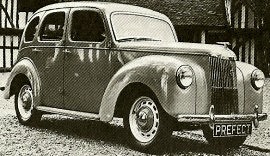 |
 |
Ford Prefect Model E493A |
| |
Also see: Ford UK Car Reviews | The History of Ford |
| |
The Ford Prefect Model E493A was continued from 1949 with no changes. It had been given a restyled front end early in that year and had an 1172cc 30-bhp L-head Four engine with three-speed gearbox. |
|
 |
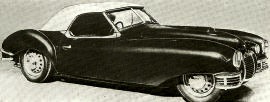 |
 |
Frazer-Nash Cabriolet |
| |
Also see: The History of Frazer-Nash |
| |
The Frazer-Nash Cabriolet was introduced in September 1949. Powered by the Bristol 1971cc engine-used in similar form on the competition Frazer-Nashes - this luxury tourer had a greater wheelbase and track than the competition models while retaining a very low overall height. It featured an ingenious windscreen, which folded down onto the scuttle, and two-folding emergency seats inside. A Mille Miglia two-seater version was also introduced. |
|
 |
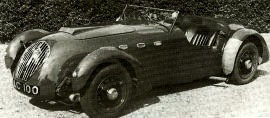 |
 |
Healey Silverstone |
| |
|
| |
The Healey Silverstone was introduced in July 1949. The open two-seater had a lightweight stressed-skin alloy sports body mounted on a D-type chassis (E-type chassis from April 1950) and was powered by a 2·5-liter Riley engine. The windscreen was retracted into the scuttle when in the racing position, instead of being folded flat; the spare wheel 'doubled' as a rear bumper and the wings were removable for competition work. Only 105 were built. We do not know if any survive to this day. |
|
 |
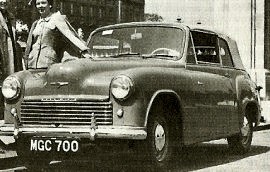 |
 |
Hillman Minx Mark IV Saloon, Convertible Coupe and Estate |
| |
Also see: Hillman Car Reviews | The History of Hillman (AUS Edition) |
| |
The Hillman Minx Mark IV Saloon, Convertible Coupe and Estate Car were introduced in December 1949. Although retaining the styling of the Mark III versions they featured more powerful engines (1265cc v. 1184·5cc) and could be quickly identified by the separate sidelamps. The left-hand drive car shown was owned by an American reporter who is photographed alongside it with a friend, in London, prior to setting off on a tour of Europe. |
|
 |
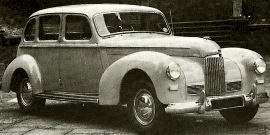 |
 |
Humber Super Snipe Mark II Saloon |
| |
Also see: Hillman Car Reviews | The History of Hillman (AUS Edition) |
| |
Humber Super Snipe Mark II Saloon. Fitted with the 4086cc 100-bhp engine (also used with the Mark I Super Snipes) and a four-speed gearbox. This six-seater model (first introduced in October 1948) incorporated detail changes for 1950 (announced in August 1949) including separate sidelamps below the headlamps. A Humber Imperial Mark II Saloon was launched late in 1949 and was virtually identical to the Pullman Limousine of that time but without the central partition. |
|
 |
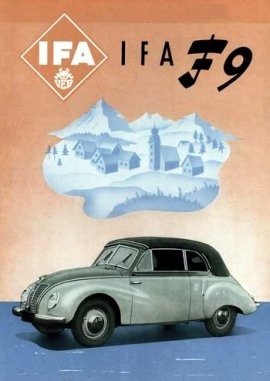 |
 |
IFA F9 |
| |
|
| |
|
|
 |
 |
 |
Jaguar Mark V Drophead Coupe |
| |
Also see: Jaguar Car Reviews | Jaguar - A Racing Pedigree |
| |
The Jaguar Mark V Drophead Coupe and its Saloon counterpart were available with a choice of 2½ or 3½ liter engines. The Mark V models were discontinued in 1951. |
|
 |
 |
 |
Jowett Javelin Jupiter Mark I Series SA |
| |
Also see: Jowett Car Reviews | The History of Jowett |
| |
The Jowett Javelin Jupiter Mark I, Series SA, was introduced in March 1950. It originated as ERA/Javelin chassis in September 1949. Powered by a Flat-4 1486-cc engine which gave over 60 bhp, this open sports model featured an aluminum panelled body with sweepingly curved wings and a rear luggage boot which could only be reached from inside the car. The whole front of the bodywork was hinged at the scuttle. |
|
 |
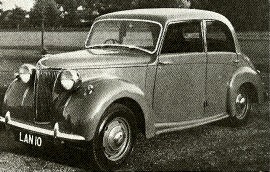 |
 |
Lanchester Ten Series L010 Saloon |
| |
Also see: The History of Lanchester |
| |
Lanchester Ten, Series L010 Saloon. In September 1949 the popular 10 HP chassis was fitted with a new four-light Barker coachbuilt body (aluminum panels on a wood and steel framework) which, although similar in appearance to the previous Briggs (steel) bodied version at the front, had a more attractive line and featured curved windows and a spacious luggage compartment. |
|
 |
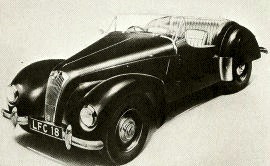 |
 |
Lea-Francis 2½-liter Sports |
| |
Also see: The History of Lea-Francis |
| |
The Lea-Francis 2½-liter Sports was introduced in September 1949 with similar general lines to the Fourteen Sports which it replaced. It was powered by a twin-carburetor 100-bhp engine and featured doors with wind-up windows and a windscreen with triangular side panels which could be removed as one assembly. It was continued in production until October 1954, when the company folded. Tradgedy. |
|
 |
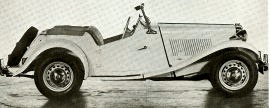 |
 |
MG Midget TD |
| |
Also see: MG Car Reviews | The MG Story | The History of MG |
| |
The MG Midget TD replaced the TC in January 1950. Although powered by the same engine it featured numerous detail improvements, including independent front suspension, rack and pinion steering, and revised gear ratios to suit its greater overall weight. The general outline of the body at the front end was modified on the lines of the Y Series open-tourer (1948-51). Its reception by MG enthusiasts of the day was decidedly cool, mainly because of its 'heavier' look, the pierced disc wheels and, above all, the inclusion of bumpers... |
|
 |
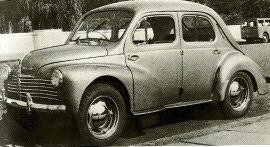 |
 |
Renault 4CV, Model R1060 |
| |
Also see: Renault Car Reviews | The History of Renault |
| |
The Renault 4CV, Model R1060, was introduced in Britain in November 1949 and assembled at the Renault Ltd plant at Acton, near London; it had originally been introduced in France in 1947, and featured a rear-mounted engine. The cubic capacity of 760 cc meant that it was just over the international 750-cc class for competition events. This was rectified in 1950 when the cylinder bore size was reduced to give it a capacity of 748 cc (R1062). |
|
 |
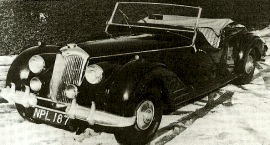 |
 |
Riley 2·1-liter Model RMC Roadster |
| |
Also see: Riley Car Reviews | The History of Riley |
| |
The Riley 2·1-liter Model RMC Roadster was produced during 1948-1950, but was only available in the domestic British market from September 1949. Originally a three-seater, it became a two-seater early in 1950. |
|
 |
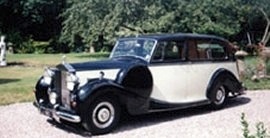 |
 |
RolIs-Royce Silver Wraith Sports Saloon |
| |
Also see: Rolls-Royce Car Reviews | The History of Rolls-Royce |
| |
RolIs-Royce Silver Wraith Sports saloon, with coachwork by Park Ward & Co, Ltd. One of these models-owned by Mr W M. Couper-took part in the 1950 Monte Carlo Rally where it won the Grand Prix d'Honneur du Concours de Contort. |
|
 |
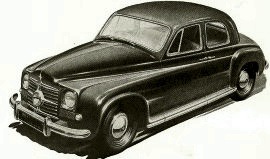 |
 |
Rover 75 Series P4 Saloon |
| |
Also see: Rover Car Reviews | The History of Rover (AUS Edition) |
| |
The Rover 75 Series P4 Saloon was introduced in September 1949, replacing the Series P3. It had completely restyled bodywork, mounted on a new full-length chassis with improved (six-cylinder twin-carb) engine, transmission and suspension. The traditional Rover appearance gave way to full-width styling with an extended boot to balance the front end. A cyclops type foglamp was mounted in the radiator grille. |
|
 |
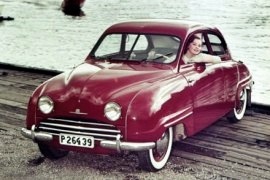 |
 |
Saab 92 |
| |
Also see: Saab Car Reviews | The History of SAAB |
| |
The Saab 92 was the Scandinavian Beetle, the car that put the common Swede on the road. It was a hugely advanced piece of work, though, and very aerodynamic (Saabs 90 and 91 were actually aircraft). |
|
 |
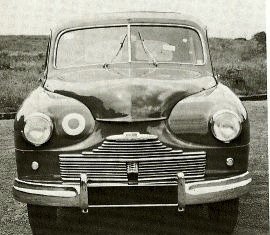 |
 |
Standard Vanguard 20S Saloon and Estate |
| |
Also see: Standard Car Reviews | The History of Standard |
| |
The Standard Vanguard 20S Saloon and Estate Car for 1950 were modified in various respects, including separate side lights, enclosed rear wheels and relocation of the gearshift lever to the left of the steering column. |
|
 |
 |
 |
Trabant |
| |
Also see: AWZ Trabant Car Reviews |
| |
The Trabant put communist-era Eastern Bloc residents on wheels, as big a revolution behind the Iron Curtain as the VW Beetle was for their western cousins. Several versions were made, but the famous P600 (plastic body, 600cc two-stroke) 'Trabbie' was made for 30 years unchanged. |
|
 |
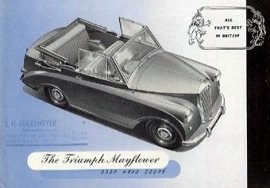 |
 |
Triumph Mayflower Drop Head Coupe |
| |
Also see: Triumph Car Reviews | The History of Triumph |
| |
The Triumph Mayflower Saloon, Series 1200T, was introduced in September 1949. This two-door, razor-edged, small car had 38-bhp 1247cc side-valve engine mounted in an integral body/chassis structure with coil-spring independent front suspension. Although the bodywork was basically a scaled-down version of the Renown, it was surprisingly roomy inside and had the same internal width (53 in). In October 1950 a limited-production Drophead Coupe version was announced. |
|
 |
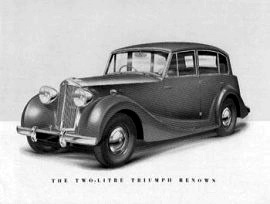 |
 |
Triumph Renown Series 20ST Saloon |
| |
Also see: Triumph Car Reviews | The History of Triumph |
| |
Triumph Renown Series 20ST Saloon. Renamed version of an earlier model. namely the 2000 Saloon (Series 20T) which, in turn, had been introduced in February 1949 to supersede the 1800 Saloon (Series 18T). Powered by the 2088cc Standard Vanguard engine, this razor-edged saloon had a box-section type chassis which replaced the tubular type used on the 1800-with independent front suspension and Lockheed hydraulic brakes. |
|
 |
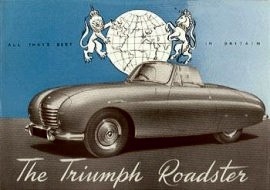 |
 |
Triumph TRX Roadster Prototype |
| |
Also see: Triumph Car Reviews | The History of Triumph |
| |
Triumph Roadster (prototype) This ambitious and very advanced model, revealed by Triumph in 1950, was a Vanguard-engined sports car fitted with striking, aerodynamic bodywork and featuring fully retractable electrically-operated headlamp covers, curved windscreen, hydraulically-operated top, windows and seats, large boot with wind-down tray for the spare wheel and a transmission with three speeds and overdrive fourth gear as standard. |
|
 |
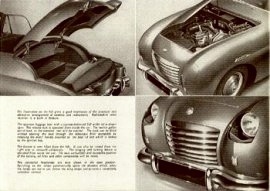 |
 |
Triumph TRX Roadster Prototype |
| |
Also see: Triumph Car Reviews | The History of Triumph |
| |
Unfortunately Triumph decided the Roadster was too complicated and expensive to produce and could not, therefore, be sold at a competitive price. Only two prototypes were built. One of the great tragedies of 20th Century motoring. |
|
 |
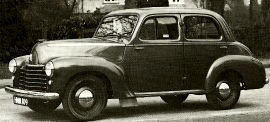 |
 |
Vauxhall Wyvern Series L1X |
| |
Also see: Vauxhall Car Reviews |
| |
The Vauxhall Wyvern, Series L1X, was a smaller engined (1442-cc 4-cyl.) stable mate of the Velox saloon (Series LIP) Externally it was similar to the Velox except that the wheels were painted in the body color (v. cream), no bumper overriders were fitted and the tire size was 5·00-16 (v. 5·90-16). Compared with 1949, 1950 editions had larger headlamps with separate sidelamps, plus various mechanical modifications. |
|
 |
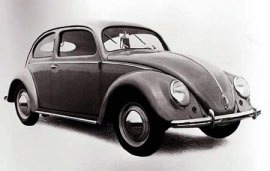 |
 |
|
| |
Also see: Volkswagen Car Reviews | The History of Volkswagen |
| |
In 1935 an Austrian engineer, who had been working for the company for less than a year, came up with a design for a flat four engine within two days of working on the project. After the accountants had checked it, it proved to be the most financially viable option. That very same engine design would go on to power the Beetle for the next 40 years. Ferdinand Porsche had been working on various other cars for other manufacturers before the Volkswagen, and incorporated some older designs within this new project. Other vehicle designs were utilized for this project, the backbone chassis and the idea of independent front and rear suspension came from the torsion bar front suspension patented by Porsche back in 1931. The body styling dated back to 1931, to a car called the "Wandere", which never reached production and the only prototype built was used by Ferdinand Porsche for his personal transport. Hitler also had plans for the styling of the Volkswagen, he is reputed to have said "It should look like a Beetle, you have to look to nature to find out what streamlining is.". Hence the name Beetle. Over the years larger engines were fitted to Beetles and minor interior and exterior changes were made, although none too dramatic. |
|
 |
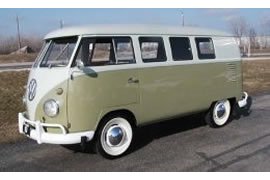 |
 |
|
| |
Also see: Volkswagen Car Reviews | The History of Volkswagen |
| |
The vehicle that represents freedom and the open road for millions; instantly recognisable, the Kombi, camper van or Magic Bus remains desirable for families, single surfers and backpackers alike. The first generation of the VW Type 2 with the split front window, called the Microbus or Kombie among Australian fans, was produced from March 8th, 1950 through the end of the 1967 model year. Like the Beetle, the Transporters used the Volkswagen air cooled four-cylinder boxer engine mounted in the rear. In 1962, a heavy-duty Transporter was introduced as a factory option. It was so successful that only a year later, the 750 kg, 1.2 L Transporter was discontinued. Among enthusiasts, it is common to refer to the different models by the number of their windows. The basic Kombi or Bus is the 11-window (a.k.a. 3-window bus because of three side windows) with the deluxe model or 13-window having eight rear side windows a split windshield, two front cabin door windows and one rear window. The Samba-Bus or Deluxe Microbus also featured unique a fold back cloth sunroof. |
|
 |
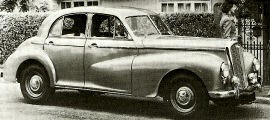 |
 |
Wolseley Six-Eighty |
| |
Also see: Wolseley Car Reviews | Wolseley Production Numbers 1940 - 1950 |
| |
The Wolseley Six-Eighty was a larger companion model to the similarly-styled four-cylinder engined Four-Fifty saloon and powered by a six-cylinder 2215cc, 72-bhp twin-carburetor engine. It also had a 9 ft 2 in (v. 8 ft 6 in) wheelbase and a greater overall length. The separate sidelights were fitted from September. The Six- Eighty was continued until October 1954 when it was replaced by the Six-Ninety.
|
|
|
